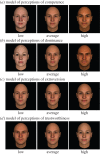Data-driven approaches in the investigation of social perception
- PMID: 27069045
- PMCID: PMC4843606
- DOI: 10.1098/rstb.2015.0367
Data-driven approaches in the investigation of social perception
Abstract
The complexity of social perception poses a challenge to traditional approaches to understand its psychological and neurobiological underpinnings. Data-driven methods are particularly well suited to tackling the often high-dimensional nature of stimulus spaces and of neural representations that characterize social perception. Such methods are more exploratory, capitalize on rich and large datasets, and attempt to discover patterns often without strict hypothesis testing. We present four case studies here: behavioural studies on face judgements, two neuroimaging studies of movies, and eyetracking studies in autism. We conclude with suggestions for particular topics that seem ripe for data-driven approaches, as well as caveats and limitations.
Keywords: ecological validity; face space; intersubject brain correlation; social neuroscience; social perception.
© 2016 The Author(s).
Figures





References
Publication types
MeSH terms
Grants and funding
LinkOut - more resources
Full Text Sources
Other Literature Sources
Medical
